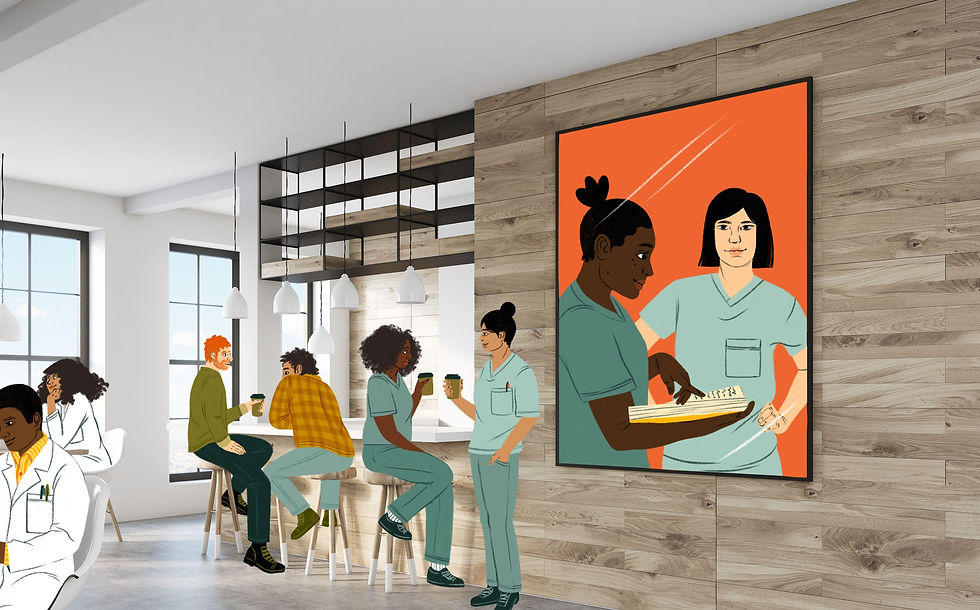How Nutrition Defeats Depression & Suicide
- Denetra Hampton
- Oct 28, 2020
- 4 min read
Updated: Jan 5, 2023
The State of Nursing Science and The Role of The Nurse Scientist

The nursing field generally evokes visions of clinical operations rather than art, science, and cultural competence. I contend that this vision gap stems from a continued lack of diversity in the nursing field—and nursing science, in particular. Nursing science has been around since the Crimean War, when its founder, Florence Nightingale,1 assembled a 38-member nursing team to document observed trends while delivering care. As a statistician, Florence collected data that helped lay the foundation for evidenced-based nursing and established nursing science as an enduring field of inquiry.
The State of Nursing Science and Diversity
Although an ongoing debate, cultural competence has been one of the leading strategies for addressing health disparities. A culturally-competent healthcare system has been defined as one that acknowledges, implements, and assesses cross-cultural relations on all levels to adapt its services for culturally-unique needs. 2 Aligned with these concepts is cultural confidence, which refers to the ability to articulate the data and science behind a particular cultural strategy. According to the 2020 National Nursing Workforce Survey, the total number of active RN and LPN/LVN licenses in the U.S. was 4,198,031 and 944,813, respectively.3 Nursing, the largest healthcare sector in the U.S., is also one the least diverse. Over 80% of registered nurses alone are white— a testament to the outdated practices and policies used to recruit and educate the profession are long outdated. The lack of diversity means cultural competence and confidence are in states of emergency in nursing science. Diversity is integral to creating a culturally-competent workforce equipped to care for medically-underserved populations while navigating a multi-discipline environment.4 Diversity also ensures resilience in the nursing workforce overall, and among its leadership, particularly in the face of multiple crises like those we have witnessed over the past two years.
The Role of the Nurse Scientist
The nurse scientist brings a unique perspective to medicine and research, providing a scientific basis for the practice of the profession. It is the study of nursing practice and how it affects patient care.5 There is a critical absence in the conversation about this role and why it is vital to health equity. Although the role is diverse in taskings, it is at the highest echelon of research that we rarely groom minorities for study—it is the study of research where we begin closing the gap of health disparities. The role has always been uniquely poised to lead in key policy change and public health initiatives. However, this change must begin from within. The nurse scientist is one of the most underrated tools of the research process, a process that still leaves vulnerable populations at whim, leading to a lack of engagement and agency. Historically, the focus of nursing research has been targeted to mostly white populations.6 This has left critical gaps in practice disparities, affecting overall health outcomes in minority populations. Although many systemic barriers have been identified that prevent racial and ethnic minorities from participating in research studies, it is the lack of cultural competence that affects research at all stages, particularly enrollment, due to inefficient communication.6 Patient perceptions of discrimination in their healthcare start with our ability or inability to communicate. Additionally, research continues to support patient-provider concordance, as it leads to better patient experiences. Nursing science must follow suit with clear, practical actionable strategies to recruit more minorities into the profession.
The Impact of Nursing Science on Health Disparities
Studies have shown that when we increase the number of health professionals of color, this is a key strategy in reducing health disparities. Unfortunately, at every point of care, access declines for people of color; and who are the primary people at every point of healthcare access? Nurses. Nursing science continues to play a significant role in the day-to-day medial operations. The global pandemic of COVID-19 has highlighted the lack of progress nursing has made in the global movement to close health disparities. Such disparities reflect inequities driven by social determinants-most notably structural racism, which itself creates and reinforces the dearth of diversity in the nursing arena. 7 Without intervention, the reach of nurse scientist, and nursing science as a discipline, will remain limited, particularly in medically-underserved communities in need of novel interventions and inquiry that can improve service delivery and health outcomes.
In Conclusion
The needs of medically-underserved populations remain both understudied and underrepresented. The impact of structural inequities follows the vulnerable population from generation to generation. The role of the Nurse Scientist is invaluable as we continue the fight to fill those gaps that continue to threaten our public health.
Florence Nightingale: The Pioneer Statistician. https://www.sciencemuseum.org.uk/objects-and-stories/florence-nightingale-pioneer-statistician
Joseph T. Betancourt, MD,MPH, Alexander R. Green, MF, J. Emilio Carrillo, MD. MPH, Owusu Ananeh-Firempong II. (July-August 2003). Defining Cultural Competence: A Practical Framework. https://www.ncbi.nlm.nih.gov/pmc/articles/PMC1497553/pdf/12815076.pdf
NCSBN (April 2021). The 2020 National Nursing Workforce Survey. https://www.journalofnursingregulation.com/article/S2155-8256(21)00027-2/fulltex
Jordan J. Cohen, Barbara A. Gabriel and Charles Terrell. (September 2002.) Health Affairs: The Case For Diversity in The Health Workforce. https:// www.healthaffairs.org/doi/abs/10.1377/hlthaff.21.5.90?journalCode=hlthaff
American Association of Colleges of Nursing. (2001). Indicators of quality in research-focused doctoral programs in nursing (position statement). Washington, DC: American Association of Colleges of Nursing. https://www.aacnnursing.org/Portals/42/News/Position-Statements/Nursing-Research.pdf
George S, Duran N, Norris K. A systematic review of barriers and facilitators to minority research participation among African Americans, Latinos, Asian Americans, and Pacific Islanders. Am J Public Health. 2014;104(2):e16-e31. doi:10.2105/AJPH.2013.301706 https://www.ncbi.nlm.nih.gov/pmc/articles/PMC3935672/
National Academies of Sciences, Engineering, and Medicine. 2021. The Future of Nursing 2020-2030: Charting a Path to Achieve Health Equity. Washington, DC: The National Academies Press. https://nam.edu/publications/the-future-of-nursing-2020-2030/?gclid=Cj0KCQjwkIGKBhCxARIsAINMioI1ChF4LQ0RXrT7BqXdMykkd_xSeNgdasIaXMyDS2OO0HWq7ndd3wQaAqmvEALw_wcB




Comments